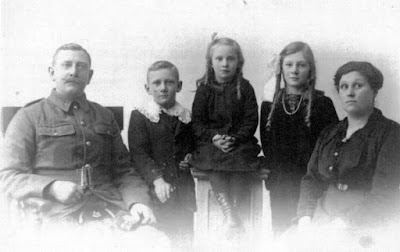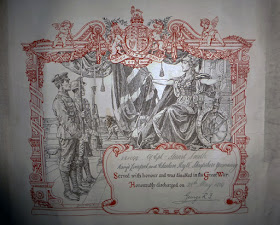A military group features in this week's Sepia Saturday prompt photograph. A cue for me to tell the sad tale of Edward Stewart Ingram Smith - my cousin's grandfather.
There were over 3 million British casualties in the First World War. Of the men who survived, their suffering could
include physical injury including loss of limbs, blindness, effects of gas
poisoning, and shell shock (what would now be termed post- traumatic
stress disorder), Many would not talk about the war or forget the scenes they
witnessed but their experiences affected their lives
ever after.
One such man was my cousin's paternal grandfather Edward Stewart Ingram Smith (1871-1923).
Edward Stewart Ingram Smith on the back row, far right with his regiment the Liverpool Scottish. An older man at 44, standing rather apart from his much younger colleagues.
Edward's Early Life
 Edward was a man of many parts - boy soldier, waiter, photographer, and upholsterer. In this photograph of him as a 20 year old young man, he has a sensitive and artistic air about him.
Edward was a man of many parts - boy soldier, waiter, photographer, and upholsterer. In this photograph of him as a 20 year old young man, he has a sensitive and artistic air about him.
Edward
was born in 1871 in Ceres, Fife, Scotland, eldest son of John Ingram
Smith and Isabella (Ella) Edward. His Ingram middle name came from
that of the minister in the Shetland Isles who had baptized his
father - and was a name adopted by future generations of Smiths, who were
very proud of their heritage on the island of Unst - the furthermost northern point of the British Isles.
In his early childhood, Edward experienced several moves across country as his father's hotel businesses failed.
Edward's daughter Ella (who lived to the age of 99) left notes relating how her father wore the kilt until he was 17 years old, played the bagpipes
and spoke Gaelic He enjoyed art and painted in oils. He was well
educated in Edinburgh and spoke with a soft lilting accent.
On leaving school, Edward joined the army as a Gordon Highlander, but did not settle and was bought out by his parents.
 By
the time of the 1891 census, 20 year old Edward was in Leeds where his
father John was manager at the Victoria Hotel. Edward's occupation
was listed as photographer.
By
the time of the 1891 census, 20 year old Edward was in Leeds where his
father John was manager at the Victoria Hotel. Edward's occupation
was listed as photographer.
A
further move by the family followed, as by 1901 Edward was working as a
waiter at the Belvedere Hotel, South Promenade, Blackpool, Lancashire.
In 1902 at Kirkham Registrar, near Blackpool, Edward married Lily
Beatrice Jones, 13 years his junior.

Ella, Edith and Arthur
In the 1911 census, Edward's occupation was still given as photographer, but illness struck and Edward had to give it up. He moved into upholstery, and eventually opened up a furniture business in Blackpool.
Called up to Serve
In the 1911 census, Edward's occupation was still given as photographer, but illness struck and Edward had to give it up. He moved into upholstery, and eventually opened up a furniture business in Blackpool.
Called up to Serve
In
1915 at the age of 44, Edward, as a previously serving soldier, was
called up to return to the army. Determined to maintain his Scottish
links, he joined the kilted Liverpool Scottish Regiment.
A serious looking family photograph, probably taken as Edward set out for war. With Arthur's hair shorn of its curls.
Edward served in France, but was gassed and injured at the Battle of the Somme. Wounded in action in the ferocious fighting in the Battle of Delville Wood, (nicknamed Devil's Wood), he was invalided back to England and hospitalised. His daughter Ella related how he went to meet her at the school gates and she did not recognize him, as his weight had dropped from 15 stone to 9 stone.
Liverpool Scottish soldiers at Dellville Wood.
An
Army Discharge Certificate (the first time I have come across one)
and Military Award Records show that Edward received the War Medal,
Victory Medal and the Silver War Badge to denote that he had been
wounded in action.
Edward's army discharge certificate. It is not a good image but I had never come across such a document before and was keen to feature it here.
Life Post-War
But
following Edward's discharge, family life proved unhappy. His mother
died in July 1919 and at some point, he separated from his wife and
children. In searching local newspapers for an item on Edward's
war service, I came across this report of 24 November 1919 in "The
Lancashire Evening Post" It made sad reading:
One
cannot help reflect that having to return to active service at the age
of 44 and face the harsh physical and mental conditions of the World
War One battlefields took its toll on Edward, as on so many soldiers.
He died in 1923 aged 52. His wife Lily survived him by a further 40
years and married for a second time.
The
photograph below shows an older Edward Stuart Ingram Smith with
haunting eyes and a dispirited air - a far cry from the smart,handsome young
man of thirty years earlier.
Adapted from a post first published in August 2016
*************
Sepia Saturday gives bloggers an opportunity
to share their family history through photographs
Click HERE to read more tales
From Sepia Saturday bloggers.










How sad indeed. A family that survived on the 30s per week might have needed a bit more, I'm thinking. I am so sorry that Edward suffered as he did following his service to his country. I am also sad that the war even happened with so much suffering as a result of it. When will humanity ever learn.
ReplyDeleteEvery time I wonder if there will ever come a time when the whole of the human race can live together in peace no matter race, creed, country affiliation or any other separation, I can only shake my head. I consider myself a positive-minded person, but I have trouble believing we will ever reach that goal. And yet, we keep trying - so who knows? We have to have hope.
ReplyDeleteI remembered your original story of Edward from that first photo where he is clearly the old man out. I have read many histories and books on the Great War, but the ones that I find most affecting are the collections of first-person accounts. This war was so very different from all the previous ones, especially in the intensity of artillery bombardment and machine gun fire, that the stress from noise and anxiety alone would cause post-traumatic disability. I now wonder if Edward's photographer's eye made his experience of the war more vivid and intense. Certainly his maturity must have made the loss of his younger comrades especially painful.
ReplyDeleteA heartbreaking story. The fact that Edward turned to drink would seem to indicate that he may have been self-medicating to deal with the post-traumatic-stress from the war. US Civil War Soldiers suffered from a similar PTSD known as "irritable heart." How unfortunate that in those years there was no treatment protocol for returning veterans -- something later generations of veterans, from the Viet Nam war on, have pressed for and received.
ReplyDeleteFrom Scotsue - thank you all for your sympathetic and thoughtful comments. I am sure Edward’s story must have been replicated in so many families. We sometimes forget the impact it must have been to be catapulted from often small rural communities into the horrors of the WW1 trenches.
ReplyDelete